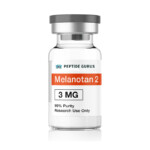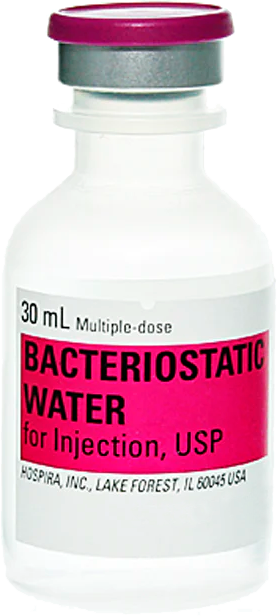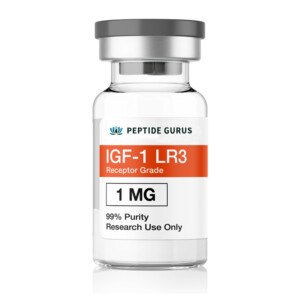Gratis (1) 30 ml de agua bacteriostática
con pedidos calificados sobre $500 Dólar estadounidense.
(excluye productos en cápsulas, péptidos cosméticos, códigos promocionales y envío)
melanotan-2 (MT-2) is a synthetic derivative of human alpha-melanocyte-stimulating hormone (α-MSH), developed at the University of Arizona in the 1980s. The initial purpose was to create a sunless tanning alternative, inspired by α-MSH’s ability to induce sexual arousal and skin darkening in rodents. Sin embargo, as research progressed, MT-2’s diverse effects were unveiled. These include enhancing sexual arousal, promoting skin pigmentation, reducing compulsive behavior, managing addiction, suppressing hunger, decreasing glucagon production, and even potentially reversing certain features associated with autism.
Uso del producto: Este PRODUCTO ESTÁ DISEÑADO ÚNICAMENTE COMO QUÍMICO DE INVESTIGACIÓN. Esta designación permite el uso de productos químicos de investigación estrictamente para pruebas in vitro y experimentación de laboratorio únicamente.. Toda la información del producto disponible en este sitio web es solo para fines educativos.. La introducción corporal de cualquier tipo en personas o animales está estrictamente prohibida por la ley.. Este producto sólo debe ser manipulado por personal autorizado., profesionales cualificados. Este producto no es un medicamento., alimento, o cosmético y no puede estar mal etiquetado, mal utilizado o mal etiquetado como droga, comida o cosmética.
What Is Melanotan 2 (MT-2)?
Melanotano 2 (MT-2) is a synthetic version of human alpha-melanocyte-stimulating hormone (α-MSH). It was originally developed in the 1980s, at the University of Arizona, after it was found that α-MSH caused sexual arousal in rodents as well as darkening of the skin. Originally designed as a sunless tanning option, MT-2 was eventually found to have a wide range of effects such as:
- increasing sexual arousal,
- promoting tanning or skin pigmentation,
- reducing compulsive behavior,
- controlling addiction,
- fighting hunger,
- reducing glucagon production, y
- reversing features of autism.
Melanotano 2 Estructura peptídica
Peptide Sequence: Nle-Asp(1)-Su-D-Phe-Arg-Trp-Lys(1)
Fórmula molecular: C50H69N15O9
Peso molecular: 1024.198 g/mol
PubChem CID: 92432
Número CAS: 121062-08-6
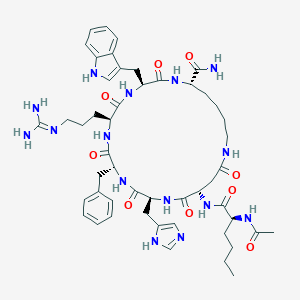
Melanotano 2 Investigación
Melanotano 2 and Melanocortin Signaling
Melanotano 2 produces its effects by binding with melanocortin receptors. There are five known melanocortin receptors, each with different function. MT-2 is known to bind primarily to MC-4R and MC-1R, but also binds weakly to MC-3R.
- MC-1R: Found on melanocytes, stimulation of MC-1R causes darkening of the skin and hair.
- MC-2R: Found in the adrenal glands, MC-2R binding promotes the secretion of adrenal hormones, such as cortisol.
- MC-3R: MC-3R is involved in appetite control and energy regulation, but little else is known about this receptor.
- MC-4R: Stimulation of MC-4R causes changes in feeding and sexual behavior. It also affects male erectile function and energy homeostasis.
- MC-5R: MC-5R is expressed on sweat glands and pancreatic islet cells.
Melanotano 2 and Autism
The newest research finding for MT-2 indicates that the peptide can reverse certain autistic features in a commonly used mouse model of autism spectrum disorder (ASD). There is no treatment for the condition, but recent search has indicated that oxytocin therapy may be useful in mitigating some of the behavioral problems associated with ASD. Using a mouse model of maternal immune activation known to lead to autism, researchers investigated whether MT2, which is known to stimulate oxytocin release, could counteract ASD or reduce common ASD behaviors. Their research revealed that administration of MT-2 reverses the decreased communication, impaired social interaction, and repetitive behaviors associated with autism in this particular model. De hecho, the researchers found that MT-2 administration increased the expression of oxytocin receptors in specific parts of the brain, suggesting a direct correlation between oxytocin signaling in those areas and ASD-specific behaviors[1].
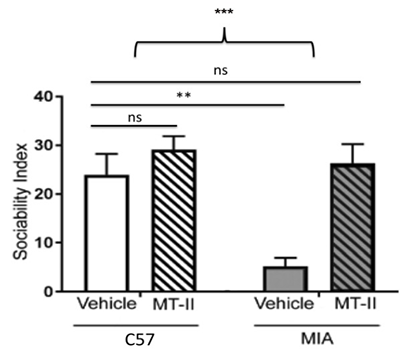
Fuente: PubMed
These findings not only suggest potential avenues for developing a treatment for ASD, they have helped to define a specific brain pathway that may be integral to the development of ASD in the first place. These findings could help scientists develop a complete model of ASD and thus both treatments and preventative measures.
Melanotano 2 and Hunger
There is good evidence to suggest that MT-2 can reduce fat storage and hunger behavior in animal models. Researchers have found that the melanocortin-4 receptor (MC-4R) plays a role in food preferences and intake and that MT-2 is a potent agonist of MC-4R. Administration of MT-2 to mice causes significant reductions in how much food they consume, but also changes their preference for fatty foods. Mice given MT-2 ignore fatty foods, which they would otherwise prefer. Similarmente, mice devoid of the MC-4R receptor consume fatty foods almost exclusively and are immune to the effects of MT-2[2].
The effects of MT-2 are similar to those of the hormone leptin, sometimes called the satiety hormone because it reduces cravings and food intake. Leptin, sin embargo, has never been useful in the treatment of obesity, even in individuals who are leptin deficient. This is likely because there are two pathways for satiety, called leptin-dependent and leptin-independent pathways. Research suggests MT-2 is more effective in stimulating both pathways and thus may be a more effective exogenous treatment for reducing hunger[3], [4]. This latter finding has been bolstered by the discovery that thyrotropin-releasing hormone (TRH) gene expression, which has long been known to play a role in the leptin-satiety pathway, is also affected by MC-4R stimulation[5]. Both MT-2 and leptin are thought to cause an increase in TRH expression in the paraventricular nucleus of the hypothalamus, a region of the brain associated with satiety and food intake, but only MT-2 crosses into the central nervous system in concentrations high enough to have an effect on TRH expression.
Melanotano 2 and Diabetes
The pathogenesis of diabetes is defined by high blood sugar levels, hypersecretion of glucagon, and the production of ketone bodies[6]. It has been known for some time that leptin counteracts these factors by increasing the uptake of glucose, suppressing glucagon production, and interfering with the pathway that leads to ketone body formation. These actions do not depend on insulin and thus leptin signaling is being actively investigated as an alternative means by which diabetes might be treated.
Research has revealed that leptin’s effects on blood sugar are regulated through melanocortin receptors and that MT-2 produces similar effects[7]. This is significant because leptin has its primary effects in the brain but does not cross the blood-brain barrier as readily as MT-2. De este modo, exogenously administered leptin does not reach the CNS in substantial quantities, a fact that reduces its effectiveness as a drug and hands an advantage to MT-2 even though the effects of the two peptides on melanocortin receptors are nearly identical.
Melanotano 2, Impulse Control and Alcohol Intake
In keeping with the idea that MT-2 may affect oxytocin signaling and thus behavior in ASD, research also reveals that the MC-4R receptor may play a role in impulse control. Past studies in rats have shown that administration of MT-2 reduces alcohol intake and increases water intake even in rats that prefer alcohol[8]. More recently, research has revealed that melanotan-2 works synergistically (boosting efficacy more than seven-fold) with naltrexone to blunt binge-like ethanol intake in mice[9].
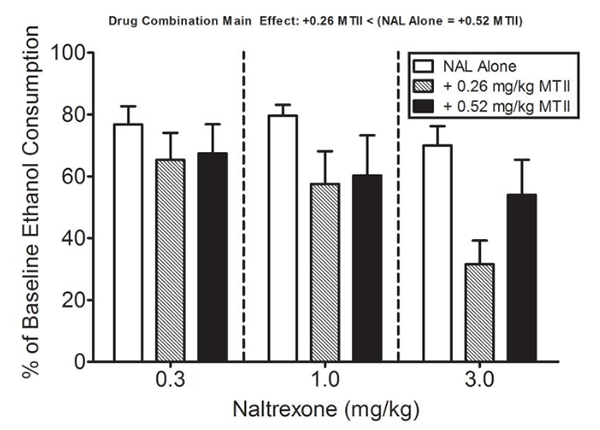
Fuente: PubMed
These findings suggest that MT-2 might not only be an effective treatment in alcohol-related disorders, but that the peptide is tapping into a more fundamental process of craving and desire in the mammalian brain. This research may open up pathways to a deeper understanding not just of alcohol abuse and hunger, but the role of oxytocin in impulsive behavior. It may even help researchers identify craving pathways and advance our understanding of human motivation in aspects of life ranging from work to relationships.
Melanotano 2 and Erectile Dysfunction
Erectile dysfunction (DE) is often attributed to vascular issues and can be effectively treated in a majority of men via sildenafil (Viagra) and other drugs that improve blood flow by reducing vascular resistance. Not all ED is due to vascular issues, sin embargo, and so sildenafil and similar drugs are ineffective in a small percentage of men and in the vast majority of women who suffer from hypoactive sexual desire disorder. It has long been known that MT-2 is an effective treatment for ED, but research suggests that it may have more wide-ranging application than drugs like sildenafil due to its actions in the central nervous system. In a study of men who had failed treatment with Viagra, eighty percent responded to MT-2 treatment[10]. MT-2 has been actively investigated in the past as a treatment for both male and female sexual desire disorders.
Melanotano 2 Impacts Wakefulness
We don’t understand a great deal about sleep and arousal, except that the regulation of consciousness is a complicated part of higher brain function. Research has revealed, sin embargo, that several different populations of neurons in the brain are critical to different aspects of arousal such as sleep onset, depth of consciousness, duration of sleep, y más. The paraventricular nucleus of the hypothalamus is one area of the brain that regulates arousal in response to stress, social interaction, feeding, and other cues.
Research using mice shows that stimulation with melanotan 2 increases arousal via interaction with neuronal fibers of the paraventricular nucleus. De hecho, stimulation of this pathway can lead to immediate transition to wakefulness from both NREM and REM sleep[13]. Further research in this area may uncover how to improve sleep and enhance concentration via the melanocortin system, making peptides like melanotan 2 potential nootropics.
Melanotano 2 and Alzheimer’s Disease
Past research has shown that activation of pro-opiomelanocortin (POMC)-derived neuropeptide can rescue some of the synaptic dysfunction that is caused by the neurofibrillary (amyloid) tangles that arise in Alzheimer’s Disease. POMC-derived neuropeptide can be activated by melanocortin receptors, so mouse models were employed to investigate whether melanotan 2 could be useful in this setting. This research showed that melanotan 2 substantially reduces amyloid accumulation and prominently reduces the A1 subtype of reactive astrocytes. This latter fact is important because A1 astrocytes are thought to be a primary driver of neurotoxicity and neuron death in Alzheimer’s Disease[14]. These findings suggests that melanocortin activation may be a potential therapeutic target in Alzheimer’s Disease. This represents a novel pathway for investigating Alzheimer’s Disease treatment and may similarly provide a means of mitigating neurotoxicity in other degenerative brain diseases.
MT-2 Research
MT-2 is a heavily researched peptide, particularly regarding human behavior, sexual desire, and impulse control. The peptide, in various forms, has been investigated in clinical trials, though problems with routes of administration have forced scientists back to the drawing board. There is active and ongoing research into the benefits of this particular peptide.
MT-2 exhibits minimal to moderate side effects, baja biodisponibilidad oral y excelente subcutánea en ratones. La dosis por kg en ratones no se aplica a los humanos. MT-2 for sale at
Autor del artículo
La literatura anterior fue investigada, editado y organizado por el Dr.. logan, MARYLAND. Dr. Logan tiene un doctorado de Facultad de Medicina de la Universidad Case Western Reserve y una licenciatura. en biología molecular.
Autor de revista científica
Dr. Wessels is a UW professor, chair of the Department of Urology, and has served on several national and international professional and government committees, including the WHO International Consultations on Erectile and Sexual Dysfunction, an NIDDK working group on urological complications of diabetes, and a NIH symposium on diabetes. He is a surgeon, researcher and expert on urogenital trauma and erectile dysfunction. His clinical interests include reconstructive surgery of the genitourinary tract, acute injury management and complex surgery for male sexual dysfunction. His research interests are in urogenital trauma epidemiology and management; the physiology and pathophysiology of erectile dysfunction; reconstructive surgery; crash injury mechanics; and urological complications of diabetes. A proerectile melanocortin agonist developed by Dr. Wessells and his collaborators at the University of Arizona is in clinical trials for the treatment of erectile dysfunction.
Dr. Wessels is being referenced as one of the leading scientists involved in the research and development of Melanotan 2. De ninguna manera este médico/científico respalda o defiende la compra, venta, o uso de este producto por cualquier motivo. No hay afiliación o relación., implícito o no, entre
Citas referenciadas
- mi. Minakova et al., “Melanotan-II reverses autistic features in a maternal immune activation mouse model of autism," Más uno, volumen. 14, No. 1, Ene. 2019. [PubMed]
- A. van der Klaauw et al., “Role of melanocortin signaling in the preference for dietary macronutrients in human beings,Lancet Lond. ingles., volumen. 385 Suplemento 1, pag. S12, Feb. 2015. [PubMed]
- h. Shimizu, k. Inoue, y M. Mori, “The leptin-dependent and -independent melanocortin signaling system: regulation of feeding and energy expenditure," J.. Endocrinol., volumen. 193, No. 1, páginas. 1–9, Abr. 2007. [Puerta de investigación]
- C. Bjørbaek and A. norte. Hollenberg, “Leptin and melanocortin signaling in the hypothalamus," Vida. Horma., volumen. 65, páginas. 281–311, 2002. [PubMed]
- F. guo, k. Bakal, Y. Minokoshi, y un. norte. Hollenberg, “Leptin Signaling Targets the Thyrotropin-Releasing Hormone Gene Promoter in Vivo,” Endocrinología, volumen. 145, No. 5, páginas. 2221–2227, Puede 2004. [PubMed]
- Y. h. Sotavento, M.-Y. Wang, X.-X. Yu, y r. h. Unger, “Glucagon is the key factor in the development of diabetes,” Diabetologia, volumen. 59, No. 7, páginas. 1372–1375, 2016. [PubMed]
- C. Toda et al., “Distinct effects of leptin and a melanocortin receptor agonist injected into medial hypothalamic nuclei on glucose uptake in peripheral tissues,” Diabetes, volumen. 58, No. 12, páginas. 2757–2765, Dic. 2009. [PubMed]
- D. A. York, S. Boghossian, y M. Park-York, “Melanocortin activity in the amygdala influences alcohol intake,Farmacéutica. bioquímica. Comportamiento., volumen. 98, No. 1, páginas. 112–119, Mar. 2011. [PubMed]
- METRO. Navarro, F. Carvajal, j. METRO. Lerma-Cabrera, I. Cubero, METRO. j. Picker, y T. mi. Thiele, “Evidence that Melanocortin Receptor Agonist Melanotan-II Synergistically Augments the Ability of Naltrexone to Blunt Binge-Like Ethanol Intake in Male C57BL/6J Mice,” Alcohol. clin. Exp. Res., volumen. 39, No. 8, páginas. 1425–1433, Ago. 2015. [PubMed]
- “Synthetic melanotropic peptide initiates erections in men with psychogenic erectile dysfunction: doble ciego, placebo controlled crossover study. – PubMed – NCBI”. [En línea]. Disponible: https://www.ncbi.nlm.nih.gov/pubmed/9679884. [Accedido: 15-mayo-2019].
- WESSELLS, h. , HRUBY, V. J., HACKETT, j. , HAN, GRAMO. , BALSE‐SRINIVASAN, PAG. and VANDERAH, t. W.. (2003), MT‐II Induces Penile Erection via Brain and Spinal Mechanisms. Annals of the New York Academy of Sciences, 994: 90-95. doi:10.1111/j.1749-6632.2003.tb03166.x
- Wessels, h. (1998). Synthetic melanotropic peptide initiates erections in men with psychogenic erectile dysfunction: Doubleblind placebo controlled crossover study. Nature.com. Available at: https://www.nature.com/articles/3900371.pdf
- METRO. t. Islam et al., “Vasopressin neurons in the paraventricular hypothalamus promote wakefulness via lateral hypothalamic orexin neurons," actual. biol. CB, páginas. S0960-9822(22)01121–6, Jul. 2022, doi: 10.1016/j.cub.2022.07.020. [PubMed]
- j. k. Y. Lau et al., “Melanocortin receptor activation alleviates amyloid pathology and glial reactivity in an Alzheimer’s disease transgenic mouse model," ciencia. Reps., volumen. 11, No. 1, pag. 4359, Feb. 2021, doi: 10.1038/s41598-021-83932-4. [PubMed]
TODOS LOS ARTÍCULOS E INFORMACIÓN DE PRODUCTOS PROPORCIONADOS EN ESTE SITIO WEB SON SÓLO PARA FINES INFORMATIVOS Y EDUCATIVOS.
Los productos ofrecidos en este sitio web se proporcionan únicamente para estudios in vitro.. Estudios in vitro (latín: en cristal) se realizan fuera del cuerpo. Estos productos no son medicamentos ni fármacos y no han sido aprobados por la FDA para prevenir, tratar o curar cualquier condición médica, dolencia o enfermedad. La introducción corporal de cualquier tipo en personas o animales está estrictamente prohibida por la ley..



